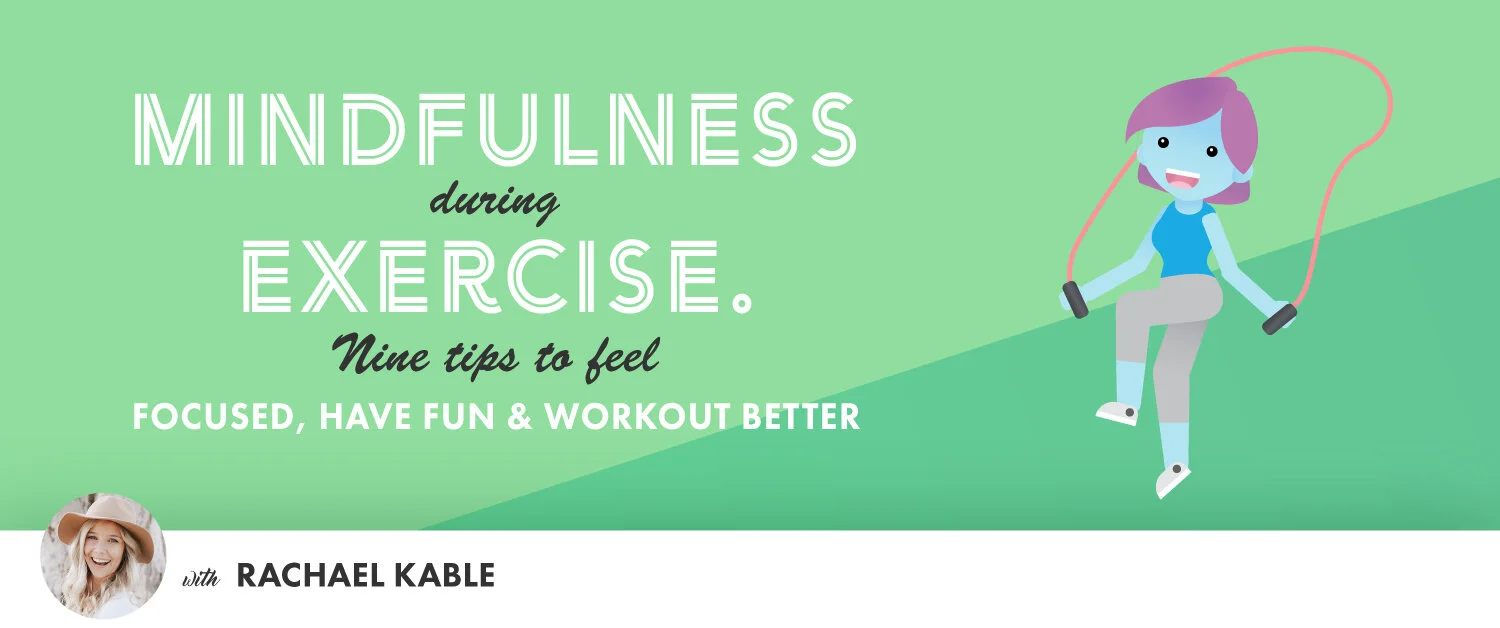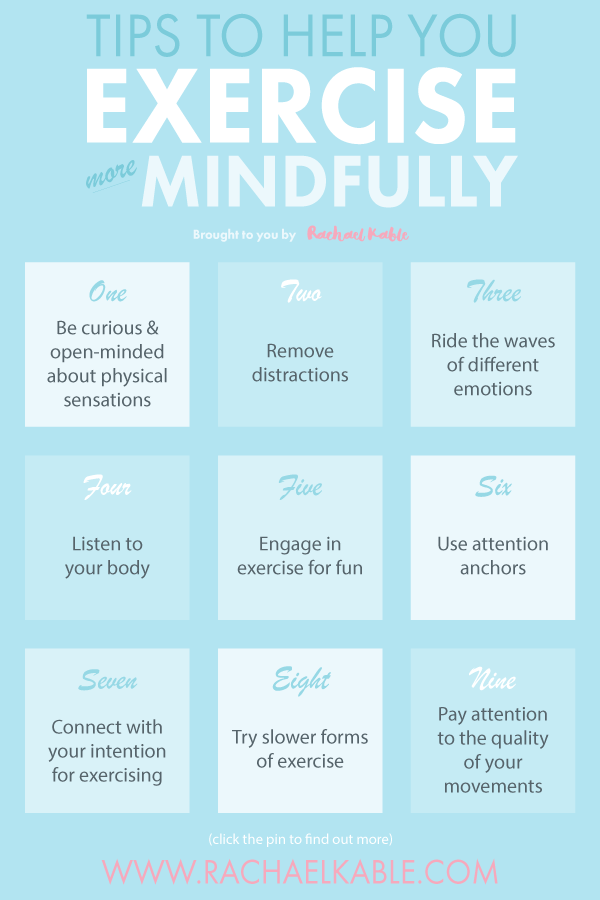Mindfulness During Exercise: 9 Tips to Feel Focused, Have Fun and Work Out Better
Regular exercise is an important part of a healthy lifestyle and good wellbeing.
Not only does exercise help protect you from health issues such as diabetes, asthma, arthritis and heart disease, it can also improve your mental health. If you exercise regularly, it can help reduce symptoms of stress, anxiety and depression while boosting confidence and sleep quality.
However, even when you know about the benefits of exercise, it can still be difficult to actually do.
You might spend a long day at work and feel exhausted by the end of it. Exercise is probably the last thing you feel like doing!
Maybe, you set some big exercise goals that are really hard to reach and as a result, you feel uninspired and disappointed.
Perhaps, you just don’t really enjoy it.
Or maybe, you like the idea of exercising more but you’re not feeling particularly motivated to start.
Well, I have some great news for you! Weaving mindfulness into your exercise routine can help in a number of ways.
Mindfulness can help you make the most of low intensity exercise (the kind of exercise you might actually enjoy at the end of a long day!).
It can help you navigate any challenging emotions which arise during exercise, such as disappointment, lack of motivation and frustration.
Mindfulness can also help you enjoy and appreciate exercise more – even when it’s challenging.
And finally, using exercise in tandem with mindfulness helps you save time by doing two beneficial activities at the same time!
Below, you’ll find 9 simple mindfulness tips you can easily incorporate into different workouts and different forms of exercise which can help facilitate more mindfulness.
Tip 1: Be curious and open-minded about physical sensations
Exercise creates various physical sensations that you can mindfully pay attention to. As you complete your exercise, allow your attention to flow between the different sensations that arise. For example, you might notice your heart rate increasing and you breathing becoming deeper. You might feel the strength or lengthening of your muscles. You might feel your cheeks becoming flushed and hot. There are so many different sensations you can pay attention to as your workout unfolds!
Tip 2: Remove distractions
If you would like to experience exercise more mindfully, try to remove distractions that pull your focus away from it.
For example, if you do yoga in the lounge room while watching television, instead try to find a quiet room where you can actually pay attention to your practice.
If you normally run while listening to music or a podcast, try leaving your phone at home so you can pay more attention to your surroundings and the feelings in your body.
The less distractions there are to pull your focus away from exercise, the easier it will be to exercise in a mindful way.
Tip 3: Ride the waves of different emotions
As you exercise, you might notice different emotions arising. Rather than judging yourself for those emotions or wishing the emotions would go away, try to simply recognise them and let them be.
For example, if you’re running and feel the need to slow down and walk for a while, you might feel disappointed or frustrated. Remind yourself that it’s okay to have those feelings and that they will come and go.
Tip 4: Listen to your body
It can also be important to listen to your body by noticing sensations such as pain, discomfort, or fatigue. Rather than ignoring sensations like these, use them to guide you. For example, pain might be a signal to stop and take a break whereas mild discomfort could be a sign that you could work harder.
Tip 5: Engage in exercise for fun
Incorporate fun types of exercise into your routine and allow yourself to let go of worries and stressors and have a good time.
Here are some types of exercise which might help you have more fun:
-Snowboarding or skiing
-Kayaking
-Playing with your children or pets
-Tennis
-Beach cricket
-Hiking
-Basketball
-Dancing
-Surfing
Not all exercise needs to be serious, challenging and results-driven. Sometimes, you can simply try new things and live more actively. Another benefit of fun types of exercise? Mindfulness can often occur naturally when you’re doing things that are out of the ordinary because they require you to pay attention!
Looking for more types of fun and mindful exercise you can incorporate into your life? Check out my video below for three mindful adventures that will help you get active AND have a good time!
Tip 6: Use attention anchors
Before you start exercising, choose one or two things you can re-focus on throughout the exercise to be your “attention anchors”. For example, your breath can be a great attention anchor because it’s always there for you to focus on and it can change during your workout.
Whenever you notice your mind wandering or if you need something to focus on, pay attention to the feeling of the breath moving in and out of your body. Alternatively, choose one part of your body where you can feel your breath, such as your nostrils, and rest your attention there.
Other attention anchors could include:
-the feeling of the ground underneath your feet
-the temperature
-the feeling of equipment you might be using
-sounds you can hear
Tip 7: Connect with your intention for exercising
When you take the time to recognise why you want to exercise, it can feel more meaningful and worthwhile. Try asking yourself “what is my main purpose for exercising today?” or “why is this workout important to me?” and reconnect with your answer at different times during your exercise to keep motivated.
Tip 8: Try slower forms of exercise
Sometimes, mindfulness can be easier to practice when there are fewer things to focus on (this is why tip number 2 about removing distractions is important!). Some forms of exercise can feel overwhelming with physical sensations, emotions, the environment and other people to focus on.
It can be helpful to find slower forms of exercise where you can more easily focus on your movements, your breath, or attention anchors.
Here are some slower types of exercise you could try:
(P.S these might be the types of exercise you could engage in at the end of the day when you don’t really feel like exercising)
-Yin yoga
-Tai chi
-Stand up paddle boarding
-Walking (click here to read more about mindful walking tips)
-Slow strength training
-Gardening
-Swimming
Tip 9: Pay attention to the quality of your movements
This is probably my favourite tip because paying attention to my movements during exercise not only helps me be more mindful, it allows me to get the most out my exercise in safe ways with better posture and form. It can be easy to forget about the quality of movements and focus on just hitting a target or goal, but the more I’ve practiced this, the more I’ve come to see that quality is often better than quantity.
For example, I used to run with my shoulders hunched forward because it often felt easier for me. When I first started trying to improve my running posture, I found myself getting tired faster and not running quite as far. However, my form was so much better and over time, I was gradually able to build back up again (but this time, with good posture).
I hope you’ve enjoyed learning more about mindfulness during exercise!
If you would like to learn more about mindfulness and how you can incorporate it into your everyday life, be sure to grab a copy of my book, The Mindful Kind! You’ll find several chapters which relate to physical health, including simple tips for a better sleep, mindful eating and conscious choices, moving your body and the pursuit of fun. Download a free chapter below for a sneak peek!






